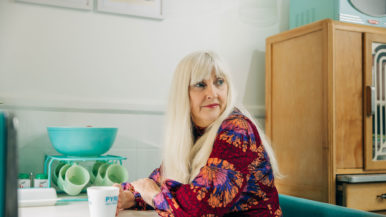“The oldest piece is a cast-iron headboard from the 1500s”: This woman designed her house around her antiques collection

Janice Fine, a stay-at-home mom, began collecting antiques in her early 20s and stored her finds in her brother’s basement. After she got divorced, she moved out of Thornhill and into a new home near Yonge and Lawrence in December of 2020, where she is surrounded by all her favourite things. Here’s how it all came together.
–As told to Isabel B. Slone
“I bought my first antique when I was 12: a pair of sterling and crystal salad tongs from France, circa 1820, as a gift for my mother. I took the bus from our home in North York to Stanley Wagman’s antique shop at Avenue and Davenport, and told him I wanted to buy something special for my mom. He helped me pick these out. They cost $150 in 1966, which was an enormous amount of money (about $1,200 today). I couldn’t believe the price. But they made my mother so happy; she brought them out at every family dinner, and I still have them.

“My mother, Roselind Shapero, came from a poor Polish Jewish family. Her mother would buy little bits of porcelain at flea markets because she liked the way they looked. They turned out to be Limoges. Ever since she was a child, my mother schlepped me along on her antique-shopping trips. I fell in love with the craftsmanship and stories behind the pieces. Later on, my mom never bought anything unless I approved it. She knew I had a sixth sense. Together, I helped her select brass and ebony sconces, as well as a number of antique silver tea and coffee pots. My favourite period is the early 19th century.
“In my late teens and early 20s, I would buy things without knowing what I was going to do with them. When I went shopping and saw ornate, decorative objects, I just wanted to possess them. The antiques would sing to me, and I couldn’t leave them behind. For example, I bought an incredible armoire made for French peasants with a bouquet of flowers carved into the wood, and stored it in my brother’s basement. I always knew in my heart I would find the perfect place for them. (I spent a lot but I never reveal what I pay.)


“I got married at 26. Seven years later, we moved into a home in Thornhill, and I stayed home to raise our two young sons. Finally, I had space for all the antiques I had been collecting. After waiting for years, I was able to take those early purchases out of my brother’s basement and put them on display, which felt wonderful. Then, I ramped up my collecting.
“I found most of my treasures on my travels in my late 20s and early 30s. My husband and I visited the silver vaults in London, where precious silver objects were piled on top of each other from floor to ceiling, like dirty laundry. I bought teapots there, as well as trays and magnifying glasses.


“Once, in Paris, we visited Hôtel Drouot, which has seven floors of auctions. People were buying furniture for huge estates, castles and villas, but I was there to buy a single chair—a chaise longue made of carved oak. The bidding was all in French and it was very fast. It was the most nervous I’ve ever been in my life, but I kept within my budget and won the chair, which I later had reupholstered in straw-covered linen.
“After 30 years, my marriage ended in 2009. My two sons were in university, and I had never lived on my own before. I stayed in the Thornhill house but it always felt so empty at night. About 10 years later, my inner voice told me, Janice, you’re ready to move now. I fell in love with a three-bedroom detached house near Yonge and Lawrence and bought it. I loved the vibe of the neighbourhood: everyone is friendly and always wants to say hello.

“The house had been renovated about a decade earlier, so everything was relatively modern. The kitchen was conventional, with stainless steel appliances and pale green backsplash. I thought it was disgusting. I planned to rip everything out and start from scratch. My goal was to create a 19th-century European country chateau. A place that makes you forget you’re in Toronto, in Canada, or even in the 21st century. I took possession in May of 2019 and started renovations immediately. The house, turned out to be built with knob-and-tube wiring so we had to replace all of the electrical. When I moved in December of 2020, the renovations weren’t finished, but the place was liveable.
“I designed the interiors to meet the specifications of the antiques I had collected, including the dining room set, which came from the old Hôtel Ritz in Paris before it was remodelled. The first thing I found a home for was my cabriolet—a carriage from the 18th century used to transport aristocratic women. It sat in my Thornhill basement for eight years. I took the doors off and used them for the built-in shoe cabinet in my dressing room. I asked my cabinet maker to salvage the rest, and he turned it into a vanity for the powder room.


“One of the pieces closest to my heart is a wooden dresser with curved sides that I got from an antique dealer in Toronto. When I saw it, it had a whitewash, but the dealer told me he wanted to strip it off to see what was underneath. I agreed. After he stripped it, he realized that it had probably originated in a French chateau circa the 1820s. The owners whitewashed their pieces during World War 2 to disguise their value so they wouldn’t be plundered by the Nazis.
“I use all my antiques, no matter how precious they are, because that’s what they’re for. They were designed to be enjoyed, not hoarded away. Hundreds of years ago, people didn’t dispose of anything, and even their most utilitarian objects were designed to be beautiful. I may have paid a great deal for all my antiques, but all my friends are re-decorating their homes for the third time whereas I’ve only bought everything once. From an early age, my mother taught me: buy once, buy right.


“The oldest piece in the house is an Italian cast-iron headboard from the 1500s. It’s spectacular, with a a family crest stamped on it. I stored it in the garage for seven years. It was originally part of a big hearth where food was cooked. You can even see the char marks at the bottom. It probably weighs around 600 pounds. I used it as a headboard for my son’s bed when he was growing up in Thornhill. He once told me he was frightened to go to bed the entire first week it was in his room. He was terrified it was going to fall on him. It took three movers to bring it upstairs. It now lives in the guest bedroom, for when my son visits.
“The kitchen is where I spend most of my time, so I wanted it to be magnificent. The backsplash tiles are from a gentleman who replaces tiles in the palaces in Portugal. The kitchen island is new but I had it painted with milk wash to make it look like it’s been in use in an old French country kitchen. When I was choosing appliances, I didn’t like anything I saw, so I asked the appliance store if they had Le Cornue, a French cooking-range manufacturer founded in the 20th century. Luckily, they did. I first wanted it back when my ex-husband and I were building our first house, but he didn’t like the idea. When I saw it, I sat down on the floor and said to it, “I loved you 42 years ago. Now’s the time. There’s nobody holding me back.”


“While the loneliness of living alone hasn’t fully dissipated, it’s wonderful to be able to express myself through my surroundings. It’s comforting and special to live among these beautiful objects. Almost every antique in my house is associated with a memory. For example, I used to give my mother a new artichoke-shaped finial each year on her birthday. Every time I walk past the collection at the top of the staircase, I’m reminded of her.
“Living in this house takes me away from modern society. I forget about Covid and everyone staring at their cellphones all the time. It puts me in a good mood. This house gives me a sense of accomplishment and fulfillment. Recently, I purchased an acorn-shaped finial I found in Stratford and some silver plates from a consignment shop in Toronto. They’re finishing touches that make the house feel complete.”





